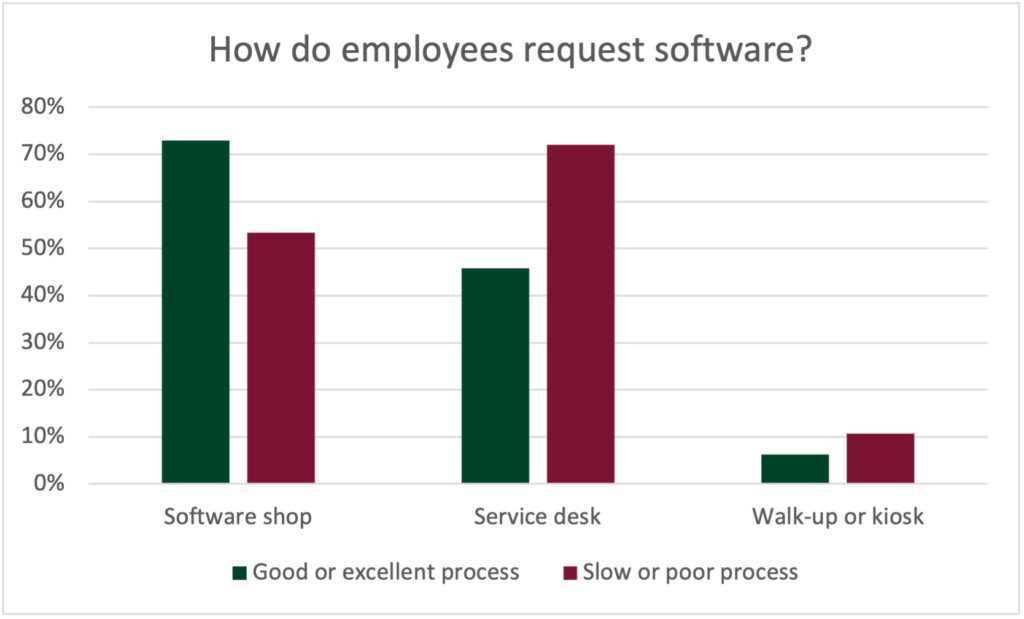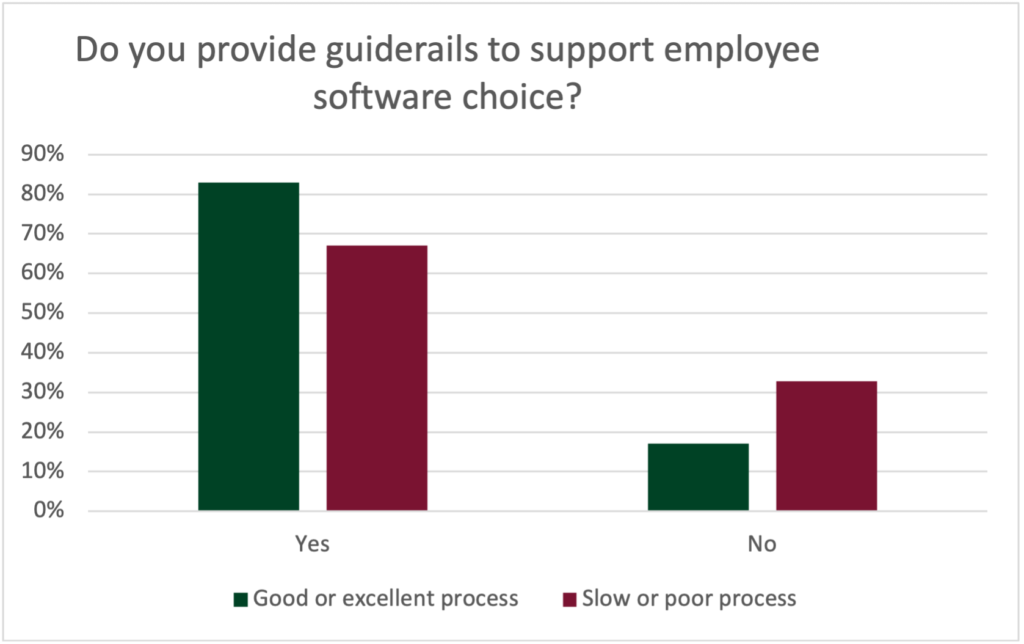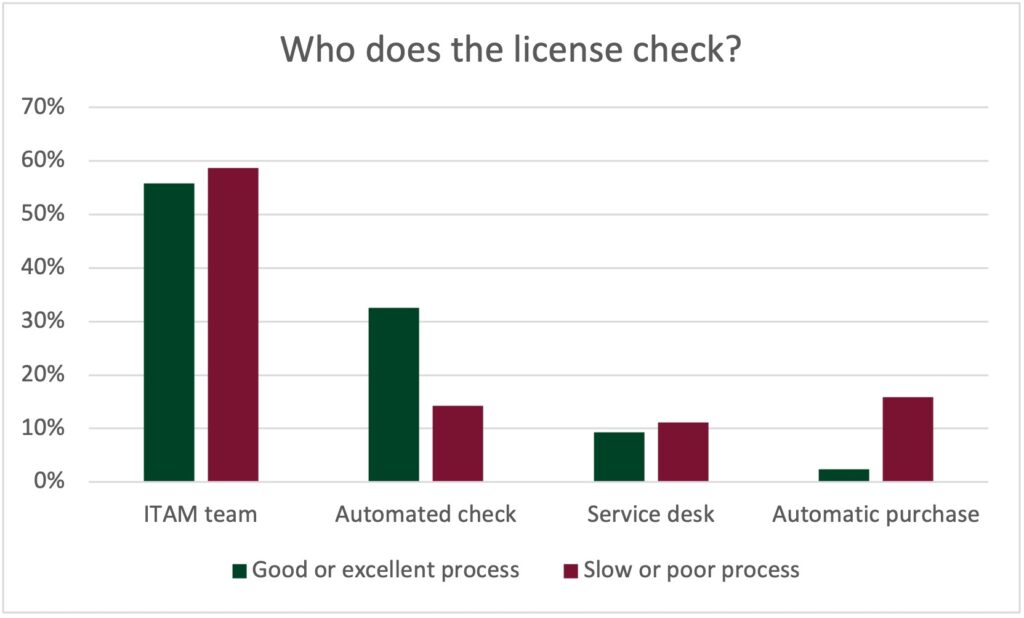The software request process is the shop window for the IT department. This is where first impressions are made and reinforced. On top of this, if we’re no good at getting software to our employees, contractors, and partners, we’re impacting their ability to perform their jobs. So, it’s no wonder a poor software request process can have an adverse impact on how the IT department is viewed by other parts of the organization!
And consider our competition: these days we can all effortlessly access an amazing array of software services and functionality online, while seamlessly downloading software from their app stores onto mobile devices/gaming consoles. It’s little wonder that the IT department is typically seen as slow to the mark.
Inspired by the book Accelerate: Building and Scaling High-Performing Technology Organizations by Nicole Forsgren (goodreads.com), I compiled a survey on key aspects of the Software Request process under the auspices of my IT Asset Management training school, ITAM Accelerate. My focus was on how certain aspects of the management of software licenses might impact the quality of the process. It was a small survey – with 123 respondents, mainly from the software licensing and IT asset management community, and respondents were asked to self-assess the quality of the software request process in their organization, as well as tell us how they performed aspects of the process (e.g. checking to see if there are any spare licenses).
Here @SmileyKylie74 shares the results of a new #ITAM survey which asks respondents to self-assess the quality of the software request process in their organization. Click To TweetDespite the small sample size and the self-assessment regarding the quality of the process, the answers to the survey were revealing. Just 39% of organizations consider themselves good or excellent at this most high profile of processes, while 61% of respondents said the service provided to employees requesting software was either poor or slow.
And if you’re inclined to discount the importance of the service provided to individual employees in relation to the service provided to project managers implementing new or improved systems and business services, the figures for project work are just as damning. Only 35% of respondents considered the service for project managers as excellent, while 65% rated it slow or poor.
When writing this survey, we hypothesized that organizations that rated their software request process as ‘good’ or ‘excellent’ would display the following characteristics:
- End users would be able to select at least some of their own software from a portal or software shop
- Organizations would provide ‘guiderails’ to help employees select the most appropriate software to meet their requirements
- Where possible, license checks would be performed automatically or by the service desk to minimize routing through the SAM team
- That the SAM team would actively engage with programs and projects to ensure they are licensed appropriately
Software Request Process Survey Findings
Before we dive into the results, please remember – correlation is not causation! Just because good or excellent performing organizations do something doesn’t mean that the activity in question caused the high performance. It’s just as likely that high performing processes just happen to include the activity, and therefore the high performing process is driving the correlation – or the finding may simply be coincidence. My statistical skills don’t extend to identifying causation, so when reading these results, please bear in mind the mantra that correlation is not causation!
1 – End user self-selection
It’s clear that software shops or request portals are becoming far more common than they once were, with over 60% of organizations telling us they’ve some sort of software portal/shop through which people can request software. However, having a software shop wasn’t associated with either good or poor processes – in fact 13 out of 48 (27%) ‘good or excellent’ organizations don’t have one at all! These organizations relied purely on employees placing requests directly with the service desk.

So clearly, a software shop type arrangement is not a pre-requisite for a lean and mean software request process! While it might help, having a software shop certainly doesn’t guarantee a good process despite the fact that the main business value is to remove the service desk, a potential bottleneck, from the equation.
2 – Organizations would provide ‘guiderails’ to help employees select appropriate software
When devising this hypothesis, my thinking was that providing ‘guiderails’ for employees would reduce bottlenecks associated with employees obtaining approval for the software they need. We offered respondents a choice of ways in which they might guide employee software selection:
- Some software may be pre-approved for end users based on their department or role in the organization
- Additional information about the software might be provided to employees, for instance the price or a description of its function
The answer to this question does reveal more of a correlation between a good or excellent process and the provision of guiderails to help employees get the software they need. While a large percentage (72%) of all organizations do provide guiderails, the results are interesting when you consider which organizations do NOT provide some sort of guiderail. A third (33%) of slow or poor performing organizations had no guiderails, while this figure was only 17% for good or excellent performing organizations.

For organizations which provide guiderails, the most common form of guiderail was the provision of additional information (e.g. price or a functionality description), while providing software based on employee profiles was – relatively speaking – much more common in good or excellent performing organizations.
So, while we must always bear in mind that correlation is NOT causation, there is no doubt that the lack of guiderails to guide employee software choice IS associated with the poor or slow organizations.
3 – Streamlined license checks
My hypothesis around license checks is that this part of the process has the potential to be a bottleneck, significantly slowing down the provision of software licenses to employees. Managing licenses is usually the domain of the SAM team, and it’s very common for software requests to be routed through the SAM or ITAM team so they can check whether there’s a spare license, or whether a purchase is required. In the survey I suggested a couple of different ways this bottleneck could be reduced:
- Automating the license check through integration between the SAM tool and the ITSM tool
- Providing information about spare licenses to the service desk so the service desk can do the license check and route the call through the appropriate workflow (deployment vs. purchase)
- Skipping the license check entirely and making the assumption that a purchase will always be required
The clear majority of organizations send all software requests to the ITAM team to perform the license check, with just over half of all organizations routing all checks through the ITAM team, irrespective of the quality of the software request process.

However, when we consider the minority of organizations that have introduced an alternative workflow, good or excellent organizations have tended to automate the check, while slow or poor organizations were much more likely to route the request through the purchase process without checking whether there is a spare license.
For me, these results are inconclusive, and more research is required to confirm the basic hypothesis that routing calls through the ITAM team represents a bottleneck that reduces the quality of the overall flow, let alone what the best alternative might be.
4 – That the ITAM team would actively engage with programs and projects to ensure they’re licensed appropriately
We had a much lower response rate to the question regarding the quality of the software request process for projects, with only 71 responses. Of these, 25 (35%) of organizations rated themselves as good or excellent, while 46 (65%) rated themselves as poor or slow. Unfortunately, the sample size is even more restricted because out of these 71 respondents, 17 didn’t have sufficient knowledge to answer the question about how and when the ITAM team is engaged by projects.
The options given to respondents were:
- If the project team asks for the price of a license or whether there are any spare licenses
- When the project team asks for help to make sure they’re licensing the solution correctly
- A formal licensing check is included in project stage gates
- The ITAM team reviews all programs and projects to identify projects which may require licensing support
- The ITAM team actively engage programs and projects to ensure the licensing aspects are managed appropriately
- I don’t know how this works in my organization!
The results show a strong correlation between including a licensing check as a formal stage gate in the project process and a good or excellent process. The flip side of this is that there’s also a strong correlation between slow or poor organizations and a more passive approach to license management, where the onus is on program and project managers to engage the ITAM team.
Finally, there’s a clear correlation between good or excellent processes and including a formal licensing check as a stage gate in the project management process, while conversely there was a strong correlation between slow or poor processes and placing the onus on projects themselves to engage with the ITAM team.
As with all these things, further research is needed. But I hope this paper does two things – 1) provide food for thought regarding the elements of a good or excellent software request process, and 2) demonstrate that performing similar research on a wider range of topics could produce some valuable insight to help organizations design high performing processes.
Over the next few months, we plan to conduct more research testing other hypotheses about which ITAM and ITSM capabilities contribute to effective IT and business processes. If you’re interested in participating in this research and are willing to be added to our database, then please complete our contact form here.
Kylie Fowler
Kylie is an experienced Software and IT Asset Management consultant with a track record of enabling companies to optimise their IT estate through the creation of best practice and compliant SAM frameworks. Adept at developing highly responsive SAM strategies that deliver reduced costs through efficient licence management and support future direction requirements, she has operated as an independent consultant since 2009, supporting organisations including DirectLine, Sainsbury’s and Thames Water to leverage the benefits of IT asset management and achieve critical business objectives.
Kylie is passionate about supporting businesses of all sizes to drive continuous improvement, reduce risk and achieve return on investment through the development of creative asset management solutions. She is a Fellow of the BCS, the Chartered Society for IT, and holds ISEB, ITIL4 and PRINCE2 certifications and is a convener of the BCS UK SAM Networking Group. She is a regular speaker at industry events and has published a number of thought leading SAM articles and whitepapers.

